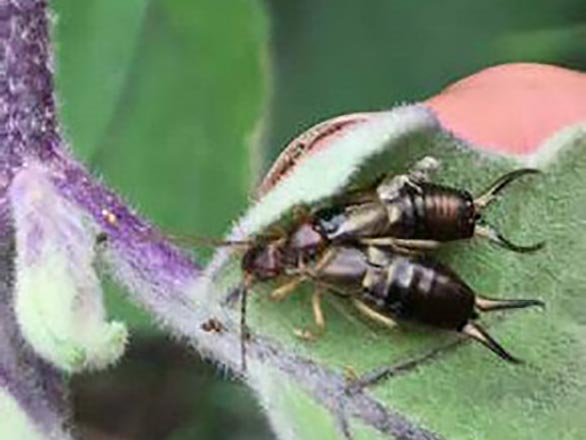 Other common name: pincer bugs
Other common name: pincer bugs
Scientific name: Forficula auricularia (European earwig)
Order: Dermaptera
Description: European earwigs are reddish-brown insects and are about a half inch long. They have a large set of pincers (cerci) on the tip of their abdomens. Male pincers are curved, while female pincers are straight. Nymphs resemble adults but lack developed wings. Adults have wings but are not known to fly.
Behavior: Earwigs hide during the day in cool, dark, undisturbed locations such as under rocks, pavers, plants or planters, or in small crevices. They are active at night from late spring to fall. Their pincers are used primarily for mating. They can pinch with their mandibles (jaws) if handled but are not known to be aggressive or harmful to humans. Females care for their young for several weeks until they are able to feed on their own.
Life cycle: Earwigs overwinter as adults. In late winter, females will create nests under rocks and sheltered areas. The eggs hatch into small nymphs in the spring. A second set of eggs is sometimes produced. Mating occurs in late summer. The females can lay several dozen eggs per season.
Diet and damage: Earwigs eat plants, soft-bodied insects and other arthropods, corn silks, vegetable seedlings, and decaying organic matter. They can reach damaging pest levels on young vegetable seedlings and ornamental plants. Earwigs create rough holes in leaves, leaving a ragged, lacy appearance. Plants can be consumed entirely and sometimes killed. Earwigs will also feed on soft fruit, leaving shallow pits.
Monitoring: Earwigs can be observed on plants at night with a flashlight. Monitoring traps can be created, which consist of shallow cans or containers placed at ground level and filled with a half inch of oil.
Control methods:
Cultural: Reduce the presence of small, dark, damp crevices that serve as hiding places. Remove refuge sites such as creeping groundcovers or thick mulches near vegetable gardens.
Mechanical: Use oil traps near earwig hiding places. These traps can also be made with plastic containers with holes drilled in the lid or on the sides to prevent waste or beneficial insects from falling into them. Alternatively, use “crevice traps” made from rolled up cardboard or newspapers to collect earwigs overnight. Dispose of earwigs in the morning. Spring tillage will disturb overwintering populations. Sticky traps can also be used around sheltering areas.
Biological: Spiders, centipedes, poultry and fowl often feed on earwigs. The tachinid fly, Bigonicheta spinipennis, is known to parasitize earwigs. Parasitic nematodes and fungal diseases are also associated with controlling earwigs.
Chemical: Commercial baits are available and should be placed around sheltering areas. Sprays can be effective if targeted toward their known sheltering areas. When applying any pesticide, read the entire product label thoroughly before application. If you see a Bee Advisory Box, this newly developed EPA label denotes a potentially high risk to bees and other pollinators.
K. Burls, W.Hanson Mazet, H. Kratsch
2021,
A Northern Nevada Homeowner's Guide to Identifying and Managing Earwigs,
Extension, University of Nevada, Reno, FS-21-108


